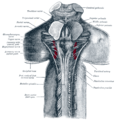Superior cerebellar peduncle
In the human brain, the superior cerebellar peduncle (brachium conjunctivum) is a paired structure of white matter that connects the cerebellum to the midbrain. It consists mainly of efferent fibers, the cerebellothalamic tract that runs from a cerebellar hemisphere to the contralateral thalamus, and the cerebellorubral tract that runs from a cerebellar hemisphere to the red nucleus. It also contains afferent tracts, most prominent of which is the ventral spinocerebellar tract. Other afferent tracts are the trigeminothalamic fibers, tectocerebellar fibers, and noradrenergic fibers from the locus coeruleus. The superior peduncle emerges from the upper and medial parts of the white matter of each hemisphere and is placed under cover of the upper part of the cerebellum.
| Superior cerebellar peduncle | |
|---|---|
 Sagittal section of the cerebellum, near the junction of the vermis with the hemisphere. (Superior peduncle labeled at upper right.) | |
 Dissection showing the projection fibers of the cerebellum. (Superior peduncle labeled at center top.) | |
| Details | |
| Identifiers | |
| Latin | pedunculus cerebellaris superior |
| NeuroNames | 833 |
| NeuroLex ID | birnlex_1711 |
| TA | A14.1.05.006 A14.1.07.417 A14.1.08.678 A14.1.06.009 A14.1.06.216 |
| FMA | 72495 |
| Anatomical terms of neuroanatomy | |
Structure
Superior cerebellar peduncles are connected together by the anterior medullary velum, which can be followed upward as far as the inferior colliculi, under which they disappear.
Below, they form the upper lateral boundaries of the fourth ventricle, but as they ascend they converge on the dorsal aspect of the ventricle and thus assist in forming its roof.
Decussation

The decussation of superior cerebellar peduncle is the crossing of fibers of the superior cerebellar peduncle across the midline, and is located at the level of the inferior colliculi. It comprises the cerebellothalamic tract, which arises from the dentate nucleus (therefore also known as dentatothalamic tract), as well as the cerebellorubral tract, which arises from the globose and emboliform nuclei and project to the contralateral red nucleus to eventually become the rubrospinal tract. It is also known as horseshoe-shaped commissure of Wernekinck.[1] It is important as an anatomical landmark, as lesions above it cause contralateral cerebellar signs, while lesions below it cause ipsilateral cerebellar signs.
Additional images
 Scheme showing the connections of the several parts of the brain.
Scheme showing the connections of the several parts of the brain. Superficial dissection of brain-stem. Lateral view.
Superficial dissection of brain-stem. Lateral view. Coronal section of the pons, at its upper part.
Coronal section of the pons, at its upper part. Sagittal section through right cerebellar hemisphere. The right olive has also been cut sagittally.
Sagittal section through right cerebellar hemisphere. The right olive has also been cut sagittally. Dissection showing the course of the cerebrospinal fibers.
Dissection showing the course of the cerebrospinal fibers. Upper part of medulla spinalis and hind- and mid-brains; posterior aspect, exposed in situ.
Upper part of medulla spinalis and hind- and mid-brains; posterior aspect, exposed in situ.
References
This article incorporates text in the public domain from page 792 of the 20th edition of Gray's Anatomy (1918)
- Voogd J, van Baarsen K (February 2014). "The horseshoe-shaped commissure of Wernekinck or the decussation of the brachium conjunctivum methodological changes in the 1840s". The Cerebellum. 13 (1): 113–20. doi:10.1007/s12311-013-0520-9. PMID 24078481.
External links
- Atlas image: n2a7p6 at the University of Michigan Health System
- Atlas image: n2a7p4 at the University of Michigan Health System
- https://web.archive.org/web/20080518232033/http://isc.temple.edu/neuroanatomy/lab/atlas/micn/
- http://www.neuroanatomy.wisc.edu/Bs97/TEXT/P18/sum.htm
- NIF Search - Decussation of superior cerebellar peduncle via the Neuroscience Information Framework